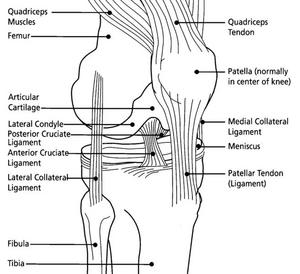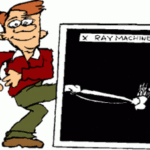Patellofemoral pain syndrome is a common, high incidence diagnosis give to individuals from teenage to adults to explain anterior knee pain. The treatment for this condition varies from conservative to surgical and offer variable results. However, one of the most beneficial treatments involves physical therapy. PFS is a condition you may now have been diagnosed with, and I want to share with you how the profession can help.
First comes an understanding of how/why patellofemoral pain occurs. With most, it is an issue of the kneecap (or patella) not tracking correctly in the femoral grove. When you straighten your leg to extend it, the kneecap must travel up and inward on the knee. When this does not occur correctly, the underside of the knee will grind against the femoral condyle, and cause the pop/crack/grind pains you may feel.
What causes this not to occur well? There are biomechanical components involved, the biggest being the Q angle that the front of the thigh makes. The Q angle measures how much pull the vastus lateralis quadriceps muscle has on the kneecap with extension. The greater the angle the greater the pull. An over pronated, or “flat” foot will do the same with alignment, as will a genu valgum or “knocked knee” posture.
Probably the most significant muscle involvment is from the weakness of the vastus medialis muscle. This muscle helps to track the kneecap, and is part of the quad. It pulls the knee more towards the inside during extension, and tends to always be found in patients with PFS symptoms. Weakness in the vastus lateralis, and tightness in the lateral retinaculum (connective tissue) on the outside of the knee and iliotibial band will also contribute.
So how can physical therapy help you? There are two components to the treatment that can be provided-one is short tem pain relief and the other is long term correction of dysfunction.
For short term relief, simple stretching of the tight muscles such as the iliotibial band, the hamstrings and the gastroc/soleus (calf) and gentle isometrics of the quad will help with the balance of strength/flexibility. The main relief though would be through RICE-Rest, Ice Compression and Elevation techniques, including coldpacks and elevation to help with any inflammatory responses. Also medications may be prescribed by your Physician to decrease the swelling and pain.
The long-term relief for the symptoms involves focusing on the VMO weakness and addressing the quad strength. Straight leg raises, wall sits and exercises with theraband or other resistive tubing can help load and strengthen the quad. Progression into weight bearing exercises such as wall sits; lunges and step training help continue to focus the vastus medial and the entire quad. Also dependent on the effect from the foot/ankle, the use of orthotics may be beneficial to you.
So overall, the field of physical therapy will help with flexibility, strength and any mechanical changes that may need to be made. Long-term relief is successful with adherence to the exercises suggested and lifestyle change. Find a physical therapist in your area, one that specializes in musclo-skeletal rehab or sports medicine and get to work!


